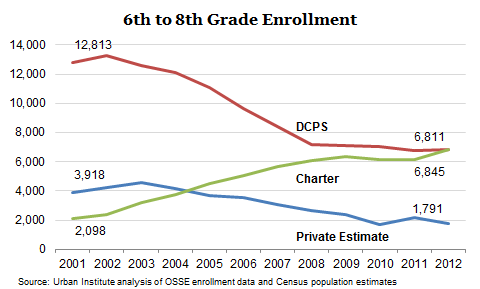
Over the past decade, private school enrollment among DC students has declined by over 65 percent, according to our analysis. Given that the number of high-income households in the District is increasing, tuition costs may not be a major factor in the change. Instead, the drop in private school enrollment could mean that more parents see public schools—both charter and traditional schools—as viable options for their children.
In 2001, approximately 7,600 DC residents ages 5 to 13 attended DC private schools; by 2012, that number had fallen to fewer than 2,600 students. (Our analysis of school enrollment figures and Census population estimates includes all students attending schools other than public schools, so it may include some homeschooled students or early dropouts.)
We see this trend at all grade levels. Private school enrollment among elementary school–age children (ages 5 to 10) fell by over 78 percent (about 2,900 students) from 2001 to 2012, with most of this decrease occurring earlier in the decade.

Enrollment in private school among middle school–age children (ages 11 to 13) fell by over 50 percent (about 2,100 students) over this same period, though most of this decline occurred fairly recently.

Private school estimates are difficult to measure for high school students because many students are held back in 9th grade and a number of students drop out at age 16. However, the data indicate that private school enrollment may be dropping rapidly among this population as well.
The preference for public schools is particularly strong among parents of elementary school children. Approximately 98 percent of elementary school children attend public schools in DC, compared with just 88 percent of middle school children.
Location matters
We also found that private school enrollment varies significantly by location, and as you may guess, is highly related to income. As of 2012, children in relatively affluent neighborhoods in Northwest and Capitol Hill have the highest rates of private school enrollment, while almost every child attends public school in other, less affluent areas of the city.


DC parents are more likely to opt for public schools than they were just a decade ago, which could be connected to the city’s major investments in schools. The last two mayors have invested in new facilities, new programming, and higher pay for teachers to attract and retain a strong workforce, and have also supported the thriving public charter schools. The new mayor can easily continue this level of investment in education, but may need to work harder to ensure these promising trends in public education continue.
Interested in learning more about how education in DC has evolved? Explore the schools chapter of Our Changing City, an interactive web feature that uses data to tell the story of change in the District of Columbia.
Let’s build a future where everyone, everywhere has the opportunity and power to thrive
Urban is more determined than ever to partner with changemakers to unlock opportunities that give people across the country a fair shot at reaching their fullest potential. Invest in Urban to power this type of work.